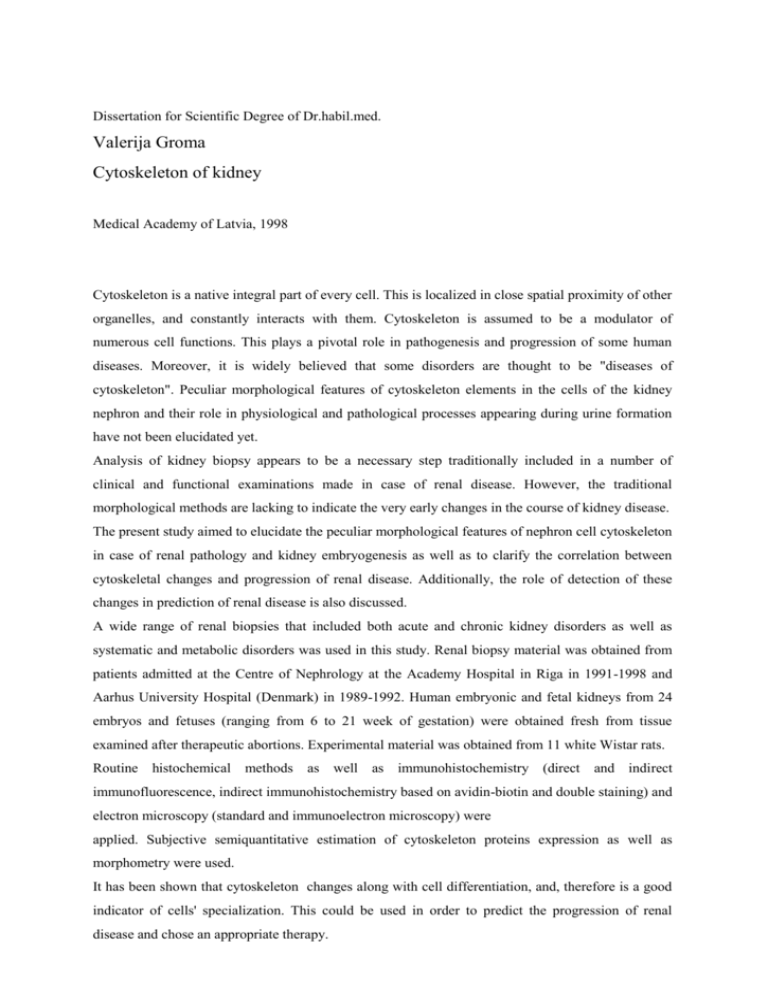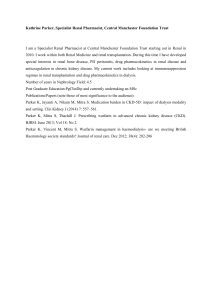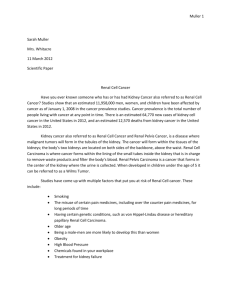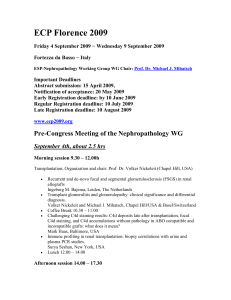Valerija Groma. Cytoskeleton of kidney. Dissertation for Scientific
advertisement

Dissertation for Scientific Degree of Dr.habil.med. Valerija Groma Cytoskeleton of kidney Medical Academy of Latvia, 1998 Cytoskeleton is a native integral part of every cell. This is localized in close spatial proximity of other organelles, and constantly interacts with them. Cytoskeleton is assumed to be a modulator of numerous cell functions. This plays a pivotal role in pathogenesis and progression of some human diseases. Moreover, it is widely believed that some disorders are thought to be "diseases of cytoskeleton". Peculiar morphological features of cytoskeleton elements in the cells of the kidney nephron and their role in physiological and pathological processes appearing during urine formation have not been elucidated yet. Analysis of kidney biopsy appears to be a necessary step traditionally included in a number of clinical and functional examinations made in case of renal disease. However, the traditional morphological methods are lacking to indicate the very early changes in the course of kidney disease. The present study aimed to elucidate the peculiar morphological features of nephron cell cytoskeleton in case of renal pathology and kidney embryogenesis as well as to clarify the correlation between cytoskeletal changes and progression of renal disease. Additionally, the role of detection of these changes in prediction of renal disease is also discussed. A wide range of renal biopsies that included both acute and chronic kidney disorders as well as systematic and metabolic disorders was used in this study. Renal biopsy material was obtained from patients admitted at the Centre of Nephrology at the Academy Hospital in Riga in 1991-1998 and Aarhus University Hospital (Denmark) in 1989-1992. Human embryonic and fetal kidneys from 24 embryos and fetuses (ranging from 6 to 21 week of gestation) were obtained fresh from tissue examined after therapeutic abortions. Experimental material was obtained from 11 white Wistar rats. Routine histochemical methods as well as immunohistochemistry (direct and indirect immunofluorescence, indirect immunohistochemistry based on avidin-biotin and double staining) and electron microscopy (standard and immunoelectron microscopy) were applied. Subjective semiquantitative estimation of cytoskeleton proteins expression as well as morphometry were used. It has been shown that cytoskeleton changes along with cell differentiation, and, therefore is a good indicator of cells' specialization. This could be used in order to predict the progression of renal disease and chose an appropriate therapy. The cytoskeleton in the nephron cells is composed of microfilaments, intermediate filaments which are supplemented by straight, slender microtubules. These have been demonstrated to be connected with organelles and are responsible for the special cellular functions. It has been shown that along with the changes of podocyte shape and foot processes fusion, the changes of actin cytoskeleton take part. The podocyte appears more dense microfilamental organization and smoothly attaches to the glomerular basement membrane. Changes of microtubules and intermediate filaments are not so prominent. Epithelial cells of the nephron bear a single cilium. Striated rootlets appear to be associated with the base of it. Immunohistochemical studies of glomerular a-smooth muscle actin expression revealed that this is a reliable marker of mesangial cell activation and is a good predictor of glomerular injury. In case of IgA nephropathy this appears to be expressed even in the practically normal at the light microscopical level glomeruli. a-smooth muscle actin expression estimated quantitatively did not correlate with the cell proliferation, proliferation index and cellularity. However, quantitative and semiquantitative asmooth muscle actin immunoreactivity data showed a good correlation. It is believed that a constant glomerular a-smooth muscle actin expression is an indicator of disease progression toward glomerulosclerosis. It has been observed that in case of renal interstitial fibrosis excessive accumulation of collagen type VI along with types I and III takes a place. This is associated with the phenotypic changes of renal fibroblasts. Many of them transform into myofibroblasts. Some transitional forms like interstitial cells with numerous lipid droplets have been observed ultrastructurally. Deposition of collagen type VI in the renal interstitium correlates with tubular atrophy. In case of prominent interstitial widening and tubular atrophy collagen accumulation correlated with the serum creatinine level. Moreover, it was revealed that TGF-p- and a-smooth muscle actin-positive cells were colocalized in the same fibrotic area. It has been observed that nephrogenic zone of embryonic kidney contains small blood vessels. These form arcades beneath the organ capsule. Different staged of glomerulogenesis could be observed in one section. Mature glomeruli appear to have numerous a-smooth muscle actin-positive mesangial areas. This phenomenon is coincident with the beginning of urine formation in the nephron.










